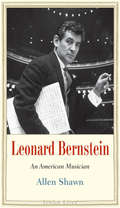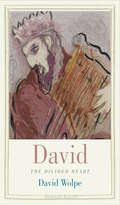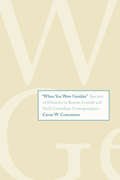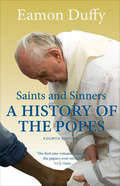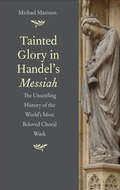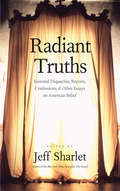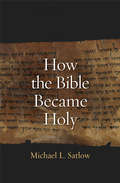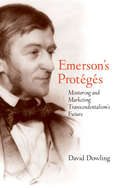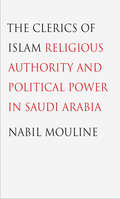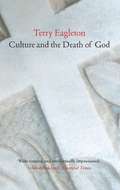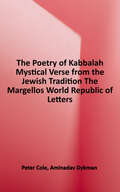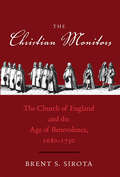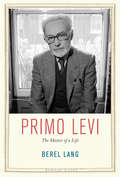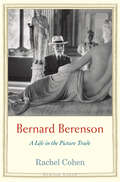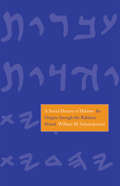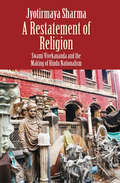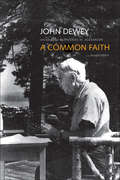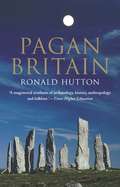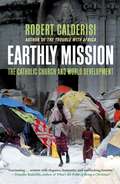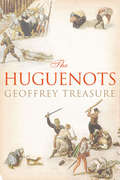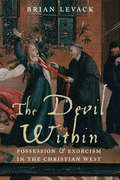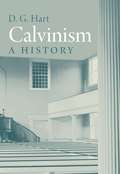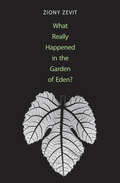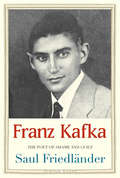- Table View
- List View
Leonard Bernstein
by Allen ShawnLeonard Bernstein stood at the epicenter of twentieth-century American musical life. His creative gifts knew no boundaries as he moved easily from the podium, to the piano, to television with his nationally celebrated Young People's Concerts, which introduced an entire generation to the joy of classical music. In this fascinating new biography, the breadth of Bernstein's musical composition is explored, through the spectacular range of music he composed--from West Side Story to Kaddish to A Quiet Place and beyond--and through his intensely public role as an internationally celebrated conductor. For the first time, the composer's life and work receive a fully integrated analysis, offering a comprehensive appreciation of a multi-faceted musician who continued to grow as an artist well into his final days.
David
by David WolpeOf all the figures in the Bible, David arguably stands out as the most perplexing and enigmatic. He was many things: a warrior who subdued Goliath and the Philistines; a king who united a nation; a poet who created beautiful, sensitive verse; a loyal servant of God who proposed the great Temple and founded the Messianic line; a schemer, deceiver, and adulterer who freely indulged his very human appetites. David Wolpe, whom Newsweek called "the most influential rabbi in America," takes a fresh look at biblical David in an attempt to find coherence in his seemingly contradictory actions and impulses. The author questions why David holds such an exalted place in history and legend, and then proceeds to unravel his complex character based on information found in the book of Samuel and later literature. What emerges is a fascinating portrait of an exceptional human being who, despite his many flaws, was truly beloved by God.
"When You Were Gentiles"
by Cavan W ConcannonCavan W. Concannon makes a significant contribution to Pauline studies by imagining the responses of the Corinthians to Paul's letters. Based on surviving written materials and archaeological research, this book offers a textured portrait of the ancient Corinthians with whom Paul conversed, argued, debated, and partnered, focusing on issues of ethnicity, civic identity, politics, and empire. In doing so, the author provides readers a unique opportunity to assess anew, and imagine possibilities beyond, Paul's complicated legacy in shaping Western notions of race, ethnicity, and religion.
Saints and Sinners: A History of the Popes; Fourth Edition
by Eamon DuffyThe latest edition of &“the most comprehensive single-volume history of the popes,&” updated to cover the election of Pope Francis (Sunday Telegraph). This engrossing book, from a professor of the history of Christianity at Cambridge, encompasses the extraordinary story of the papacy, from its beginnings to the present day, as empires rose and fell around it. This new edition covers the unprecedented resignation of Benedict XVI, and the historic election of the first Argentinian pope. Praise for the earlier editions: &“Duffy enlivens the long march through church history with anecdotes that bring the different pontiffs to life…Saints and Sinners is a remarkable achievement.&”—The Times (London) &“A distinguished text…offering plenty of historical facts and sobering, valuable judgments.&”—TheNew York Times Book Review &“Will fascinate anyone wishing to better understand the history of the Catholic Church and the forces that have shaped the role of the papacy.&”—Christian Century
The Ten Commandments: A Short History of an Ancient Text
by Michael CooganAre the Commandments really written in stone? A biblical scholar offers an &“engrossing and enlightening guide to one of the world&’s great legal codes&” (Booklist). In this lively, provocative book, Michael Coogan takes us into the ancient past to examine the Ten Commandments, also known as the Decalogue. How, among all the laws reportedly given on Mount Sinai, did the Ten Commandments become the Ten Commandments? When did that happen? There are several versions of the Decalogue in the Old Testament, so how have different groups determined which is the most authoritative? Why were different versions created? Coogan discusses the meanings the Ten Commandments had for audiences in biblical times and observes that the form of the ten proscriptions and prohibitions was not fixed—as one would expect since they were purported to have come directly from God—nor were the Commandments always strictly observed. In later times as well, Jews and especially Christians ignored and even rejected some of the prohibitions, although the New Testament clearly acknowledges the special status of the Ten Commandments. Today it is plain that some of the values enshrined in the Decalogue are no longer defensible, such as the ownership of slaves and the labeling of women as men&’s property. Yet in line with biblical precedents, the author concludes that while a literal observance of the Ten Commandments is misguided, some of their underlying ideals remain valid in a modern context.
Tainted Glory in Handel's Messiah
by Michael MarissenEvery Easter, audiences across the globe thrill to performances of Handel’s "Hallelujah Chorus,” but they would probably be appalled to learn the full extent of the oratorio’s anti-Judaic message. In this pioneering study, respected musicologist Michael Marissen examines Handel’s masterwork and uncovers a disturbing message of anti-Judaism buried within its joyous celebration of the divinity of the Christ. Discovering previously unidentified historical source materials enabled the author to investigate the circumstances that led to the creation of the Messiah and expose the hateful sentiments masked by magnificent musical artistry--including the famed "Hallelujah Chorus,” which rejoices in the "dashing to pieces” of God’s enemies, among them the "people of Israel”. Marissen’s fascinating, provocative work offers musical scholars and general readers alike an unsettling new appreciation of one of the world’s best-loved and most widely performed works of religious music.
Radiant Truths
by Jeff SharletLouisa Catherine Johnson Adams, wife and political partner of John Quincy Adams, became one of the most widely known women in America when her husband assumed office as sixth president in 1825. Shrewd, intellectual, and articulate, she was close to the center of American power over many decades, and extensive archives reveal her as an unparalleled observer of the politics, personalities, and issues of her day. Louisa left behind a trove of journals, essays, letters, and other writings, yet no biographer has mined these riches until now. Margery Heffron brings Louisa out of the shadows at last to offer the first full and nuanced portrait of an extraordinary first lady. The book begins with Louisa's early life in London and Nantes, France, then details her excruciatingly awkward courtship and engagement to John Quincy, her famous diplomatic success in tsarist Russia, her life as a mother, years abroad as the wife of a distinguished diplomat, and finally the Washington, D.C., era when, as a legendary hostess, she made no small contribution to her husband's successful bid for the White House. Louisa's sharp insights as a tireless recorder provide a fresh view of early American democratic society, presidential politics and elections, and indeed every important political and social issue of her time.
How the Bible Became Holy
by Michael L SatlowBeginning with Walt Whitman singing hymns at a wounded soldier's bedside during the Civil War, this surprising and vivid anthology ranges straight through to the twenty-first century to end with Francine Prose crying tears of complicated joy at the sight of Whitman's words in Zuccotti Park during the brief days of the Occupy movement. The first anthology of its kind, Radiant Truths gathers an exquisite selection of writings by both well-known and forgotten American authors and thinkers, each engaged in the challenges of writing about religion, of documenting "things unseen." Their contributions to the genre of literary journalism-the telling of factual stories using the techniques of fiction and poetry-make this volume one of the most exciting anthologies of creative nonfiction to have emerged in years. Jeff Sharlet presents an evocative selection of writings that illuminate the evolution of the American genre of documentary prose. Each entry may be savored separately, but together the works enrich one another, engaging in an implicit and continuing conversation that reaches across time and generations.Including works by: Walt Whitman Henry David Thoreau Mark Twain Meridel Le Sueur Zora Neale Hurston Mary McCarthy James Baldwin Norman Mailer Ellen Willis Anne Fadiman John Jeremiah Sullivan Francine Prose Garry Wills and many others
Emerson's Protégés
by Prof. David DowlingIn the late 1830s, Ralph Waldo Emerson, American essayist, poet, lecturer, and leader of the Transcendentalist movement, publicly called for a radical nationwide vocational reinvention, and an idealistic group of collegians eagerly responded. Assuming the role of mentor, editor, and promoter, Emerson freely offered them his time, financial support, and anti-materialistic counsel, and profoundly shaped the careers of his young acolytes--including Henry David Thoreau, renowned journalist and women's rights advocate Margaret Fuller, and lesser-known literary figures such as Samuel Ward and reckless romantic poets Jones Very, Ellery Channing, and Charles Newcomb. Author David Dowling's history of the professional and personal relationships between Emerson and his protégés--a remarkable collaboration that alternately proved fruitful and destructive, tension-filled and liberating--is a fascinating true story of altruism, ego, influence, pettiness, genius, and the bold attempt to reshape the literary market of the mid-nineteenth century.
The Clerics of Islam
by Ethan S. Rundell Nabil MoulineFollowers of Muhammad b. ’Abd al-Wahhab, often considered to be Islam’s Martin Luther, shaped the political and religious identity of the Saudi state while also enabling the significant worldwide expansion of Salafist Islam. Studies of the movement he inspired, however, have often been limited by scholars’ insufficient access to key sources within Saudi Arabia. Nabil Mouline was granted rare interviews and admittance to important Saudi archives in preparation for this groundbreaking book, the first in-depth study of the Wahhabi religious movement from its founding to the modern day. Gleaning information from both written and oral sources and employing a multidisciplinary approach that combines history, sociology, and Islamic studies, Mouline presents a new reading of this movement that transcends the usual resort to polemics.
Culture and the Death of God
by Terry EagletonHow to live in a supposedly faithless world threatened by religious fundamentalism? Terry Eagleton, formidable thinker and renowned cultural critic, investigates in this thought-provoking book the contradictions, difficulties, and significance of the modern search for a replacement for God. Engaging with a phenomenally wide range of ideas, issues, and thinkers from the Enlightenment to today, Eagleton discusses the state of religion before and after 9/11, the ironies surrounding Western capitalism's part in spawning not only secularism but also fundamentalism, and the unsatisfactory surrogates for the Almighty invented in the post-Enlightenment era. The author reflects on the unique capacities of religion, the possibilities of culture and art as modern paths to salvation, the so-called war on terror's impact on atheism, and a host of other topics of concern to those who envision a future in which just and compassionate communities thrive. Lucid, stylish, and entertaining in his usual manner, Eagleton presents a brilliant survey of modern thought that also serves as a timely, urgently needed intervention into our perilous political present.
The Poetry of Kabbalah: Mystical Verse From The Jewish Tradition
by Peter ColeThe first ever English-language collection of poetry from the Kabbalistic tradition, masterfully translated by MacArthur-winning poet Peter Cole This groundbreaking collection presents for the first time in English a substantial body of poetry that emerges directly from the sublime and often startling world of Jewish mysticism. Taking up Gershom Scholem’s call to plumb the “tremendous poetic potential” concealed in the Kabbalistic tradition, Peter Cole provides dazzling renderings of work composed on three continents over some fifteen hundred years. In addition to the translations and the texts in their original languages, Cole supplies a lively and insightful introduction, along with accessible commentaries to the poems. Aminadav Dykman adds an elegant afterword that places the work in the context of world literature. As a whole, the collection brings readers into the fascinating force field of Kabbalistic verse, where the building blocks of both language and existence itself are unveiled. Excerpts from The Poetry of Kabbalah have been featured in the Paris Review, Poetry, and Conjunctions. “Studded with insight, and written with great verve, this book will become a classic.”―Lawrence Fine, author of Physician of the Soul, Healer of the Cosmos
The Christian Monitors
by Brent S. SirotaThis original and persuasive book examines the moral and religious revival led by the Church of England before and after the Glorious Revolution, and shows how that revival laid the groundwork for a burgeoning civil society in Britain. After outlining the Church of England's key role in the increase of voluntary, charitable, and religious societies, Brent Sirota examines how these groups drove the modernization of Britain through such activities as settling immigrants throughout the empire, founding charity schools, distributing devotional literature, and evangelizing and educating merchants, seamen, and slaves throughout the British empire-all leading to what has been termed the "age of benevolence. "
Primo Levi
by Ariella Lang Berel LangIn 1943, twenty-four-year-old Primo Levi had just begun a career in chemistry when, after joining a partisan group, he was captured by the Italian Fascist Militia and deported to Auschwitz. Of the 650 Italian Jews in his transport, he was one of fewer than 25 who survived the eleven months before the camp's liberation. Upon returning to his native Turin, Levi resumed work as a chemist and was employed for thirty years by a company specializing in paints and other chemical coatings. Yet soon after his return to Turin, he also began writing--memoirs, essays, novels, short stories, poetry--and it is for this work that he has won international recognition. His first book, If This Is a Man, issued in 1947 after great difficulty in finding a publisher, remains a landmark document of the twentieth century. Berel Lang's groundbreaking biography shines new light on Levi's role as a major intellectual and literary figure--an important Holocaust writer and witness but also an innovative moral thinker in whom his two roles as chemist and writer converged, providing the "matter" of his life. Levi's writing combined a scientist's attentiveness to structure and detail, an ironic imagination that found in all nature an ingenuity at once inviting and evasive, and a powerful and passionate moral imagination. Lang's approach provides a philosophically acute and nuanced analysis of Levi as thinker, witness, writer, and scientific detective.
Bernard Berenson
by Rachel CohenWhen Gilded Age millionaires wanted to buy Italian Renaissance paintings, the expert whose opinion they sought was Bernard Berenson, with his vast erudition, incredible eye, and uncanny skill at attributing paintings. They visited Berenson at his beautiful Villa I Tatti, in the hills outside Florence, and walked with him through the immense private library--which he would eventually bequeath to Harvard--without ever suspecting that he had grown up in a poor Lithuanian Jewish immigrant family that had struggled to survive in Boston on the wages of the father's work as a tin peddler. Berenson's extraordinary self-transformation, financed by the explosion of the Gilded Age art market and his secret partnership with the great art dealer Joseph Duveen, came with painful costs: he hid his origins and felt that he had betrayed his gifts as an interpreter of paintings. Nevertheless his way of seeing, presented in his books, codified in his attributions, and institutionalized in the many important American collections he helped to build, goes on shaping the American understanding of art today. This finely drawn portrait of Berenson, the first biography devoted to him in a quarter century, draws on new archival materials that bring out the significance of his secret business dealings and the way his family and companions--including his patron Isabella Stewart Gardner, his lover Belle da Costa Greene, and his dear friend Edith Wharton--helped to form his ideas and his legacy. Rachel Cohen explores Berenson's inner world and exceptional visual capacity while also illuminating the historical forces--new capital, the developing art market, persistent anti-Semitism, and the two world wars--that profoundly affected his life.
A Social History of Hebrew
by William M. SchniedewindMore than simply a method of communication shared by a common people, the Hebrew language was always an integral part of the Jewish cultural system and, as such, tightly interwoven into the lives of the prophets, poets, scribes, and priests who used it. In this unique social history, William Schniedewind examines classical Hebrew from its origins in the second millennium BCE until the Rabbinic period, when the principles of Judaism as we know it today were formulated, to view the story of the Israelites through the lens of their language. Considering classical Hebrew from the standpoint of a writing system as opposed to vernacular speech, Schniedewind demonstrates how the Israelites' long history of migration, war, exile, and other momentous events is reflected in Hebrew's linguistic evolution. An excellent addition to the fields of biblical and Middle Eastern studies, this fascinating work brings linguistics and social history together for the first time to explore an ancient culture.
A Restatement of Religion
by Jyotirmaya SharmaIn this third installment of his comprehensive history of "Indias religion" and reappraisal of Hindu identity, Professor Jyotirmaya Sharma offers an engaging portrait of Swami Vivekananda and his relationship with his guru, the legendary Ramakrishna. Sharmas work focuses on Vivekanandas reinterpretation and formulation of diverse Indian spiritual and mystical traditions and practices as "Hinduism" and how it served to create, distort, and justify a national self-image. The author examines questions of caste and the primacy of the West in Vivekanandas vision, as well as the systematic marginalization of alternate religions and heterodox beliefs. In doing so, Professor Sharma provides readers with an incisive entryway into nineteenth- and twentieth-century Indian history and the rise of Hindutva, the Hindu nationalist movement. Sharmas illuminating narrative is an excellent reexamination of one of Indias most controversial religious figures and a fascinating study of the symbiosis of Indian history, religion, politics, and national identity. It is an essential story for anyone interested in the evolution of one of the worlds great religions and its role in shaping contemporary India.
A Common Faith
by John Dewey Thomas M. AlexanderIn "A Common Faith, " eminent American philosopher John Dewey calls for the "emancipation of the true religious quality" from the heritage of dogmatism and supernaturalism that he believes characterizes historical religions. He describes how the depth of religious experience and the creative role of faith in the resources of experience to generate meaning and value can be cultivated without making cognitive claims that compete with or contend with scientific ones. <P><P> In a new introduction, Dewey scholar Thomas M. Alexander contextualizes the text for students and scholars by providing an overview of Dewey and his philosophy, key concepts in "A Common Faith, " and reactions to the text.
Pagan Britain
by Ronald Huttonith the breadth of his understanding of Britain's deep past and inspires with the originality of his insights.
Earthly Mission
by Robert CalderisiWith 1. 2 billion members, the Catholic Church is the worlds largest organization and perhaps its most controversial. The Churchs obstinacy on matters like clerical celibacy, the role of women, birth control, and the child abuse scandal has alienated many Catholics, especially in the West. Yet in Africa, Asia, and Latin America, the Church is highly esteemed for its support of education, health, and social justice. In this deeply informed book, Robert Calderisi unravels the paradoxes of the Catholic Churchs role in the developing world over the past 60 years. Has the Catholic Church on balance been a force for good? Calderisi weighs the Churchs various missteps and poor decisions against its positive contributions, looking back as far as the Spanish Conquest in Latin America and the arrival of missionaries in Africa and Asia. He also looks forward, highlighting difficult issues that threaten to disrupt the Churchs future social role. The authors answer to the question he poses will fascinate Catholic and non-Catholic readers alike, providing a wealth of insights into international affairs, development economics, humanitarian concerns, history, and theology.
The Huguenots
by Geoffrey TreasureFrom the author of Louis XIV, an unprecedented history of the entire Huguenot experience in France, from hopeful beginnings to tragic diaspora. Following the Reformation, a growing number of radical Protestants came together to live and worship in Catholic France. These Huguenots survived persecution and armed conflict to win—however briefly—freedom of worship, civil rights, and unique status as a protected minority. But in 1685, the Revocation of the Edict of Nantes abolished all Huguenot rights, and more than 200,000 of the radical Calvinists were forced to flee across Europe, some even farther. In this capstone work, Geoffrey Treasure tells the full story of the Huguenots&’ rise, survival, and fall in France over the course of a century and a half. He explores what it was like to be a Huguenot living in a &“state within a state,&” weaving stories of ordinary citizens together with those of statesmen, feudal magnates, leaders of the Catholic revival, Henry of Navarre, Catherine de&’ Medici, Louis XIV, and many others. Treasure describes the Huguenots&’ disciplined community, their faith and courage, their rich achievements, and their unique place within Protestantism and European history. The Huguenot exodus represented a crucial turning point in European history, Treasure contends, and he addresses the significance of the Huguenot story—the story of a minority group with the power to resist and endure in one of early modern Europe&’s strongest nations. &“A formidable work, covering complex, fascinating, horrifying and often paradoxical events over a period of more than 200 years…Treasure&’s work is a monument to the courage and heroism of the Huguenots.&”—Piers Paul Read, The Tablet
The Devil Within: Possession & Exorcism in the Christian West
by Brian LevackA fascinating, wide-ranging survey of the history of demon possession and exorcism through the ages.In the sixteenth and seventeenth centuries, the era of the Reformation, thousands of Europeans were thought to be possessed by demons. In response to their horrifying symptoms—violent convulsions, displays of preternatural strength, vomiting of foreign objects, displaying contempt for sacred objects, and others—exorcists were summoned to expel the evil spirits from victims&’ bodies. This compelling book focuses on possession and exorcism in the Reformation period, but also reaches back to the fifteenth century and forward to our own times.Entire convents of nuns in French, Italian, and Spanish towns, thirty boys in an Amsterdam orphanage, a small group of young girls in Salem, Massachusetts—these are among the instances of demon possession in the United States and throughout Europe that Brian Levack closely examines, taking into account the diverse interpretations of generations of theologians, biblical scholars, pastors, physicians, anthropologists, psychiatrists, and historians. Challenging the commonly held belief that possession signals physical or mental illness, the author argues that demoniacs and exorcists—consciously or not—are following their various religious cultures, and their performances can only be understood in those contexts.&“Riveting [and] readable . . . must-reading for students of history, psychology and religion.&” —Publishers Weekly&“Levak, a distinguished historian of early modern witchcraft, now sets exorcism in a long historical perspective, providing the most comprehensive and scholarly overview of the theme yet published.&” —Peter Marshall, Times Literary Supplement
Calvinism
by Prof. Darryl HartThis briskly told history of Reformed Protestantism takes these churches through their entire 500-year history--from sixteenth-century Zurich and Geneva to modern locations as far flung as Seoul and São Paulo. D. G. Hart explores specifically the social and political developments that enabled Calvinism to establish a global presence. Hart's approach features significant episodes in the institutional history of Calvinism that are responsible for its contemporary profile. He traces the political and religious circumstances that first created space for Reformed churches in Europe and later contributed to Calvinism's expansion around the world. He discusses the effects of the American and French Revolutions on ecclesiastical establishments as well as nineteenth- and twentieth-century communions, particularly in Scotland, the Netherlands, the United States, and Germany, that directly challenged church dependence on the state. Raising important questions about secularization, religious freedom, privatization of faith, and the place of religion in public life, this book will appeal not only to readers with interests in the history of religion but also in the role of religion in political and social life today.
What Really Happened in the Garden of Eden?
by Ziony ZevitA provocative new interpretation of the Adam and Eve story from an expert in Biblical literature.The Garden of Eden story, one of the most famous narratives in Western history, is typically read as an ancient account of original sin and humanity&’s fall from divine grace. In this highly innovative study, Ziony Zevit argues that this is not how ancient Israelites understood the early biblical text. Drawing on such diverse disciplines as biblical studies, geography, archaeology, mythology, anthropology, biology, poetics, law, linguistics, and literary theory, he clarifies the worldview of the ancient Israelite readers during the First Temple period and elucidates what the story likely meant in its original context.Most provocatively, he contends that our ideas about original sin are based upon misconceptions originating in the Second Temple period under the influence of Hellenism. He shows how, for ancient Israelites, the story was really about how humans achieved ethical discernment. He argues further that Adam was not made from dust and that Eve was not made from Adam&’s rib. His study unsettles much of what has been taken for granted about the story for more than two millennia—and has far-reaching implications for both literary and theological interpreters.&“Classical Hebrew in the hands of Ziony Zevit is like a cello in the hands of a master cellist. He knows all the hidden subtleties of the instrument, and he makes you hear them in this rendition of the profoundly simple story of Adam, Eve, the Serpent, and their Creator in the Garden of Eden. Zevit brings a great deal of other biblical learning to bear in a surprisingly light-hearted book.&”―Jack Miles, author of God: A Biography
Franz Kafka: The Poet of Shame and Guilt
by Saul FriedlanderFranz Kafka was the poet of his own disorder. Throughout his life he struggled with a pervasive sense of shame and guilt that left traces in his daily existenceâ "in his many letters, in his extensive diaries, and especially in his fiction. This stimulating book investigates some of the sources of Kafkaâ TMs personal anguish and its complex reflections in his imaginary world.In his query, Saul Friedländer probes major aspects of Kafkaâ TMs life (family, Judaism, love and sex, writing, illness, and despair) that until now have been skewed by posthumous censorship. Contrary to Kafkaâ TMs dying request that all his papers be burned, Max Brod, Kafkaâ TMs closest friend and literary executor, edited and published the authorâ TMs novels and other works soon after his death in 1924. Friedländer shows that, when reinserted in Kafkaâ TMs letters and diaries, deleted segments lift the mask of â œsainthoodâ ? frequently attached to the writer and thus restore previously hidden aspects of his individuality.
